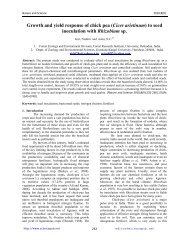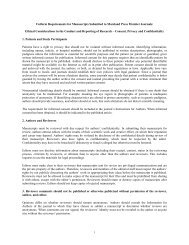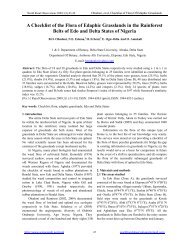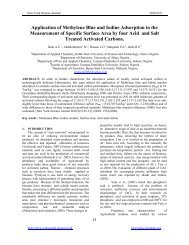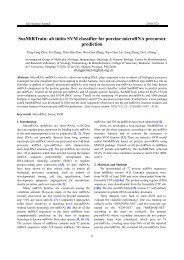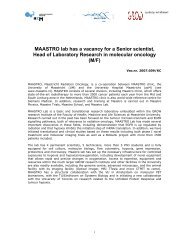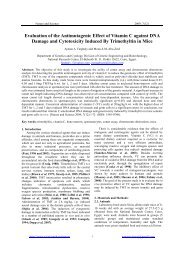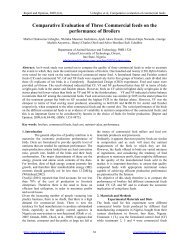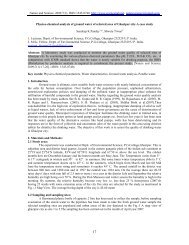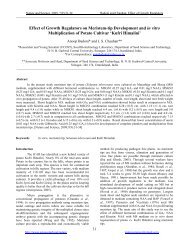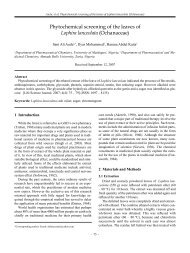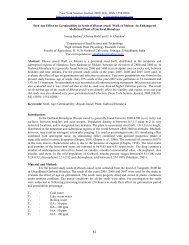Ecological, Social and Commercial Role of Lichens in India with ...
Ecological, Social and Commercial Role of Lichens in India with ...
Ecological, Social and Commercial Role of Lichens in India with ...
You also want an ePaper? Increase the reach of your titles
YUMPU automatically turns print PDFs into web optimized ePapers that Google loves.
Acdemia Arena 2010, Supplement 0201<br />
http://www.sciencepub.net<br />
tip <strong>of</strong> the twigs shows less number <strong>of</strong> <strong>in</strong>dividuals. There is a great decrease <strong>in</strong> lichen<br />
abundance <strong>with</strong> decreas<strong>in</strong>g twig diameter.<br />
The Parmelioid genera Everniastrum cirrhatum, E. nepalense <strong>and</strong> parmotrema nilgherrense<br />
<strong>with</strong> 18, 9 <strong>and</strong> 10 <strong>in</strong>dividuals respectively, dom<strong>in</strong>ate the twigs towards the tips while <strong>in</strong>dividual <strong>of</strong><br />
other lichen exhibit their poor presence there.<br />
The luxuriance <strong>of</strong> lichen growth on Quercus twigs may possibly be attributed to the<br />
retention <strong>of</strong> moisture because <strong>of</strong> their hang<strong>in</strong>g position. The flow <strong>of</strong> ra<strong>in</strong> water <strong>and</strong> that <strong>of</strong> the<br />
melt<strong>in</strong>g snow along the hang<strong>in</strong>g twigs perhaps provide greater exposure to moisture. However,<br />
accord<strong>in</strong>g to Pike et al. (1975), twigs be<strong>in</strong>g at the edge <strong>of</strong> the trees canopy receive higher levels <strong>of</strong><br />
light than most <strong>of</strong> the rema<strong>in</strong><strong>in</strong>g surfaces <strong>of</strong> the tree. Ra<strong>in</strong>fall strikes foliage <strong>and</strong> twigs directly <strong>and</strong><br />
these receive additional water which drips from higher branch system. Because <strong>of</strong> the exposure,<br />
<strong>and</strong> the low water hold<strong>in</strong>g capacity <strong>of</strong> the bark, twigs dry out quickly after ra<strong>in</strong>fall. Twigs can<br />
however hold a considerable load <strong>of</strong> snow dur<strong>in</strong>g <strong>and</strong> after wet snow fall.<br />
Wolseley <strong>and</strong> Pryor (1999) studied the lichen communities on twigs <strong>of</strong> Quercus petrarea <strong>in</strong><br />
Welsh woodl<strong>and</strong> site <strong>and</strong> concluded that there is a correlation between environmental condition <strong>and</strong><br />
lichen communities <strong>of</strong> twigs. Roughness, bark pH <strong>and</strong> chemistry <strong>of</strong> twigs, amount <strong>of</strong> moisture as<br />
ra<strong>in</strong> tracks or humidity, degree <strong>of</strong> illum<strong>in</strong>ation, aspect <strong>and</strong> illum<strong>in</strong>ation <strong>of</strong> the surface, acidification<br />
<strong>of</strong> the atmosphere are the specific characteristics <strong>of</strong> the substratum <strong>in</strong>fluence the growth <strong>of</strong> lichens<br />
on twigs. The environmental conditions were more or less similar <strong>in</strong> all the st<strong>and</strong>s <strong>of</strong> the study area<br />
except the aspects <strong>of</strong> the illum<strong>in</strong>ation at few sites. Both Parmelioid <strong>and</strong> fruticose lichens were<br />
evident on the twigs than elsewhere. The crustose lichens were abundant on apical areas <strong>of</strong> the<br />
young twigs <strong>and</strong> covered a substantial area. Accord<strong>in</strong>g to Essen et al (1996), the fruticose<br />
pendulous species (Alectoria <strong>and</strong> Bryoria) are highly sensitive to forest practices <strong>and</strong> are strongly<br />
related to age <strong>of</strong> branches while type <strong>of</strong> forest has no significant effect on foliose lichens. Similarly<br />
all the three Oaks <strong>in</strong> the study area share growth <strong>of</strong> common foliose <strong>and</strong> fruticose lichens.<br />
McCune (1993) while study<strong>in</strong>g the epiphyte biomass <strong>in</strong> three Pseudotsuga-Tsuga forest <strong>in</strong><br />
western Oregon <strong>and</strong> Wash<strong>in</strong>gton, recorded greater epiphyte biomass <strong>in</strong> old-growth st<strong>and</strong>s than the<br />
younger st<strong>and</strong>s. Similarly <strong>in</strong> the present study Q. semecarpifolia comprised <strong>of</strong> mostly the oldgrowth<br />
forest st<strong>and</strong>s exhibited greater number <strong>of</strong> <strong>in</strong>dividuals. Based on the ecological roles rather<br />
than taxonomy the epiphytic lichens <strong>of</strong> the Oak trees can be grouped <strong>in</strong>to Parmelioid<br />
82






